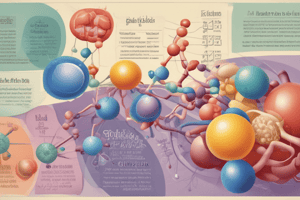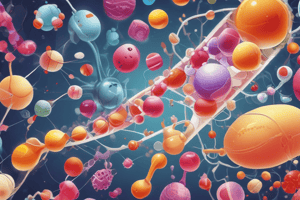Podcast
Questions and Answers
What are the main functions of vitamins in the body?
What are the main functions of vitamins in the body?
Vitamins promote growth and health by acting as co-factors and coenzymes in various metabolic processes.
List two examples of water-soluble vitamins.
List two examples of water-soluble vitamins.
Thiamin (B1) and Vitamin C are examples of water-soluble vitamins.
What are some common symptoms associated with vitamin deficiencies?
What are some common symptoms associated with vitamin deficiencies?
Common symptoms include fatigue, weakness, and compromised immune function.
Explain the role of regulated fortification in improving nutrient profiles.
Explain the role of regulated fortification in improving nutrient profiles.
How do digestive enzymes affect vitamin absorption?
How do digestive enzymes affect vitamin absorption?
Where in the body is 40-90% of vitamins absorbed?
Where in the body is 40-90% of vitamins absorbed?
What do fat-soluble vitamins require for absorption?
What do fat-soluble vitamins require for absorption?
What are the inactive forms of vitamins used in the body known as?
What are the inactive forms of vitamins used in the body known as?
What role does Thiamin (B1) play in energy metabolism?
What role does Thiamin (B1) play in energy metabolism?
What are common symptoms of Thiamin (B1) deficiency?
What are common symptoms of Thiamin (B1) deficiency?
What is the upper tolerable limit (TUL) for niacin intake in adults?
What is the upper tolerable limit (TUL) for niacin intake in adults?
From which amino acid can niacin be synthesized indirectly?
From which amino acid can niacin be synthesized indirectly?
What are the symptoms associated with niacin deficiency, commonly referred to as the 3 D's?
What are the symptoms associated with niacin deficiency, commonly referred to as the 3 D's?
What is one reason niacin deficiency is seen more often in countries with maize-based diets?
What is one reason niacin deficiency is seen more often in countries with maize-based diets?
What role does niacin play in energy metabolism?
What role does niacin play in energy metabolism?
Which vitamin is required for over 100 enzyme reactions in the body and involves amino acid synthesis?
Which vitamin is required for over 100 enzyme reactions in the body and involves amino acid synthesis?
How is niacin measured in food sources?
How is niacin measured in food sources?
What mandatory addition is often made to cereals and meal replacements involving Vitamin B6?
What mandatory addition is often made to cereals and meal replacements involving Vitamin B6?
What are the consequences of Vitamin B6 deficiency?
What are the consequences of Vitamin B6 deficiency?
What is the AI for biotin intake in adults?
What is the AI for biotin intake in adults?
Explain the difference between folate in foods and folic acid in supplements.
Explain the difference between folate in foods and folic acid in supplements.
Why is folate critical during early pregnancy?
Why is folate critical during early pregnancy?
What populations are particularly at risk for Vitamin B12 deficiency?
What populations are particularly at risk for Vitamin B12 deficiency?
What can Vitamin B12 deficiency lead to?
What can Vitamin B12 deficiency lead to?
What role does Vitamin C play in the body?
What role does Vitamin C play in the body?
What can excessive intake of folic acid mask in the body?
What can excessive intake of folic acid mask in the body?
What is the TUL for folate intake from supplements?
What is the TUL for folate intake from supplements?
List two food sources high in biotin.
List two food sources high in biotin.
Flashcards
Water-soluble vitamins
Water-soluble vitamins
Vitamins dissolved in water and not stored in the body, requiring regular intake.
B Vitamins
B Vitamins
A group of chemically distinct compounds acting as co-factors/coenzymes, essential for metabolic functions.
Vitamin function
Vitamin function
Vitamins are organic compounds that promote growth and health.
Vitamin sources
Vitamin sources
Signup and view all the flashcards
Vitamin deficiencies
Vitamin deficiencies
Signup and view all the flashcards
Fat-soluble vitamin absorption
Fat-soluble vitamin absorption
Signup and view all the flashcards
Vitamin absorption efficiency
Vitamin absorption efficiency
Signup and view all the flashcards
Thiamin (B1) function
Thiamin (B1) function
Signup and view all the flashcards
Riboflavin (B2) coenzymes
Riboflavin (B2) coenzymes
Signup and view all the flashcards
Vitamin precursors
Vitamin precursors
Signup and view all the flashcards
Niacin deficiency symptom
Niacin deficiency symptom
Signup and view all the flashcards
Niacin's role in energy metabolism
Niacin's role in energy metabolism
Signup and view all the flashcards
Niacin's connection to tryptophan
Niacin's connection to tryptophan
Signup and view all the flashcards
Niacin equivalent (NE)
Niacin equivalent (NE)
Signup and view all the flashcards
Why maize causes niacin deficiency
Why maize causes niacin deficiency
Signup and view all the flashcards
Vitamin B6's role in amino acid metabolism
Vitamin B6's role in amino acid metabolism
Signup and view all the flashcards
Mandatory fortification of Vitamin B6
Mandatory fortification of Vitamin B6
Signup and view all the flashcards
Vitamin B6's role in tryptophan conversion
Vitamin B6's role in tryptophan conversion
Signup and view all the flashcards
Vitamin B6 deficiency symptom
Vitamin B6 deficiency symptom
Signup and view all the flashcards
Biotin's role
Biotin's role
Signup and view all the flashcards
Folate in food vs. supplements
Folate in food vs. supplements
Signup and view all the flashcards
What is DFE?
What is DFE?
Signup and view all the flashcards
Folate deficiency consequence
Folate deficiency consequence
Signup and view all the flashcards
Folate deficiency and anemia
Folate deficiency and anemia
Signup and view all the flashcards
Folate's role in pregnancy
Folate's role in pregnancy
Signup and view all the flashcards
Vitamin B12 source
Vitamin B12 source
Signup and view all the flashcards
B12 deficiency symptom
B12 deficiency symptom
Signup and view all the flashcards
Excessive folic acid effect
Excessive folic acid effect
Signup and view all the flashcards
Study Notes
Intro to Nutrition - Water-Soluble Vitamins (Chapter 8)
- Vitamins are essential for growth and health.
- Water-soluble and fat-soluble vitamins exist.
- B vitamins are a group of distinct compounds that act as co-factors/coenzymes.
- B-complex vitamins include B1, B2, B12.
- The word "vitamin" comes from the Latin "vita" (life) and "amine."
- Vitamins are commonly found in grains, vegetables, and fruits.
Vitamins Objectives
- Describe the role of vitamins in normal physiological function/metabolism.
- Identify dietary sources of each vitamin.
- Outline the Dietary Reference Intakes (DRI) for each vitamin in adults.
- Discuss symptoms and pathologies associated with vitamin deficiencies.
Vitamins in the Digestive Tract
- Digestive enzymes release vitamins from food.
- 40-90% of vitamins from food are absorbed in the small intestine.
- Fat-soluble vitamins are packaged as chylomicrons.
- Some vitamins are absorbed in precursor forms.
- The absorbed vitamins are transported to the blood or lymph.
Vitamins function as coenzymes and cofactors
- Vitamins combine with a chemical group to create a functional coenzyme (active vitamin).
- The functional coenzyme combines with an incomplete enzyme to create an active enzyme.
- The active enzyme binds to one or more molecules to accelerate the chemical reaction
- The new molecules are released, and the enzyme and vitamin can be reused.
B Vitamins: Co-enzymes for energy metabolism
- B vitamins are coenzymes in energy metabolism.
- They are involved in glycolysis and other metabolic processes.
Thiamin (B1)
- Coenzyme in pentose (ribose for RNA) and acetylcholine (ACh) production.
- Widely available in enriched grains and whole grains.
- Deficiency symptoms include neurological symptoms like lethargy, fatigue, and foot drop, more common in people in poorer countries (e.g. white rice). Can also cause congestive heart failure and weakness/irritability throughout the body.
Riboflavin (B2)
- Coenzyme in energy metabolism.
- Crucial for the Krebs cycle.
- Easily destroyed by heat and light.
- Deficiency symptoms include inflammation of the eyes, lips, mouth, tongue and skin eruptions, cracked lips.
- This is rarely seen alone and is commonly associated with other B vitamin deficiencies.
- Sources include the same as thiamin (grains, vegetables, etc.)
Niacin (B3)
- Nicotinic acid, nicotinamide, are important metabolic coenzymes.
- Can be synthesized from tryptophan.
- Important role in energy metabolism, NAD/NADH, NADP.
- Involved in serotonin production and CNS functioning.
- Deficiency can lead to dermatitis (3D's: dermatitis, diarrhea, and dementia), cracked skin, and also fatigue, reduced appetite, and indigestion.
Vitamin B6
- Also called pyridoxal, pyridoxine, or pyridoxamine.
- Converted to pyridoxal phosphate, is crucial for >100 enzyme reactions.
- Coenzyme in amino acid synthesis and helps convert tryptophan to niacin.
- Is involved in immune response, steroid hormone action, neurotransmitter and myelin synthesis, glycogen metabolism, and hemoglobin synthesis.
- Mandatory in meal replacements/simulated egg products and can be added to cereals.
- Deficiency can lead to neurological symptoms like impaired hemoglobin synthesis, depression, headaches, confusion, numbness, and tingling.
Biotin (B7)
- Found in liver, egg yolks, yogurt, and nuts.
- Coenzyme involved in adding a COOH group to other molecules (e.g. citric acid cycle, glucose synthesis).
- Deficiency might result in hair loss, dermatitis, nausea, and neuromuscular dysfunction.
- Recommended intake for adults is 30 µg/day.
Folate/Folic Acid (B9)
- Found in various foods, and can be fortified.
- Crucial for DNA replication, synthesis and expression, metabolism of amino acids (especially during pregnancy), homocysteine breakdown.
- Essential for supporting growth and development of tissues, especially pregnancy during early pregnancy.
- Deficiency can produce megaloblastic/macrocytic anemia and neural tube defects.
- DFE (Dietary Folate Equivalent) conversions exist between folate and folic acid.
- High levels of folate intake during pregnancy may reduce the risk of neural deficiencies.
Vitamin B12
- Primarily found in animal products, like nutritional yeast and certain algae/seaweed.
- Necessary for myelin production, single-carbon metabolism.
- Important for some dietary modifications.
- Pernicious anemia (inability to absorb B12 in the gut), megaloblastic/macrocytic anemia, unrelated to iron are common deficiencies.
- Can be provided via injection, gel, and mega-dosage.
- Excessive folic acid intake can mask B12 deficiencies.
Vitamin C
- Also known as ascorbic acid.
- Plays many crucial roles like support, production processes (especially involving iron), scavenging.
- Sensible to heat/light/oxygen and can be destroyed during food preparation.
- Important in collagen synthesis, strengthening connective tissues.
- Deficiency in vitamin C can lead to abnormal/weak connective tissue.
Studying That Suits You
Use AI to generate personalized quizzes and flashcards to suit your learning preferences.




